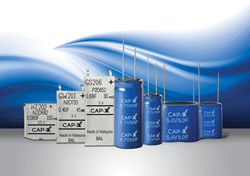source: SB wire article
Future Market Insights has announced the addition of the “Super Capacitor Market: Global Industry Analysis and Opportunity Assessment 2016-2026″ report to their offering.
Valley Cottage, NY — (SBWIRE) — 06/06/2017 — A super capacitor or an ultra-capacitor, is a high-capacity electrochemical capacitor with capacitance values as large as thousand farads. Super capacitors combines the properties of traditional batteries and capacitor in a single component. Super capacitors find their usage in applications requiring rapid charge/discharge time rather than long term energy storage. They are used for regenerative braking, burst-mode power delivery or short-term energy storage within trains, cranes, cars, buses, elevators and hybrid electric vehicles (HEV). Smaller units of super capacitors are utilized as memory backup for static random-access memory (SRAM). Additionally, super capacitors are also used in applications involving solar power, batteries, battery back-up, and flash-lights. The main differences between normal capacitor and super capacitors are; the plates of a super capacitor have a larger surface area and the distance between them is much smaller, as compared to the conventional capacitors as result it can able store extremely large amount of energy.
The consistent increasing demand of super capacitor has continuously been increasing globally and expected to grow with CAGR in double digits & the same scenario might be seen for next six to seven years in global super capacitor market.
Super Capacitor: Market Dynamics
For last some years, demand for super capacitor have been increasing in the consumer electronics and energy and utility sector, which are coming out as a new trend for super capacitor market. The key growth drivers of global super capacitor market are revolution in the storage technology with the introduction of new market segments such as hybrid electric vehicles (HEV), smart grids, and renewable energy systems, and also the advanced features provided by super capacitor such as capability of super capacitor to provide backup power to low power equipment such as RAM, SRAM, micro-controllers and PC Cards at a time of power shutdown. Additionally, rising demand of super capacitors for stabilized power supply to electronic products such as laptop computers, GPS, portable media players, hand-held devices are some of the factor driving the growth of global super capacitor market. On the other hand high cost, customer traditionalism and high level competition from the established high capacity batteries vendors are some of the restraints responsible to hinder the growth of global super capacitor market.
Super Capacitor: Segmentation
Market segmentation for super capacitor is done on the basis of technology, material type, application and region. On the basis of technology, global super capacitor market is segmented into organic electrolyte super capacitor and aqueous electrolyte super capacitor. Of these two segments organic electrolyte super capacitor is more popular than other one.
By material types, global super capacitor market is segmented into electrodes, electrolyte and separators. These segments is further sub segmented into their corresponding sub segments, as; sub segments of electrodes segment include electrolyte double layer capacitor (ELDC), Pseudo-capacitor, and hybrid capacitor materials. Electrolyte segments is sub segmented into aqueous electrolyte and organic electrolyte and separator is sub segmented into polymeric film, poly acrylonitrile (PAN) and kapton.
On the basis of application, global super capacitor market is segmented into consumer electronics (laptops, digital cameras, portable speakers and mobile computing), industrial automation (memory storage, uninterrupted power supply (UPS) and automatic meter reading), power & energy (actuators, wind turbines and photovoltaic), medical (defibrillators), transport (trains, cranes, cars, buses, elevators, aircrafts and hybrid electric vehicles (HEV))
Geographically, super capacitor market is segmented into seven regions which are; North America, Latin America, Western Europe, Eastern Europe, Japan, Asia Pacific Excluding Japan (APEJ), and Middle East and Africa (MEA). Western Europe region is dominating the global super capacitor market whereas Asia-Pacific is ranked as fasted growing market because of rapid industrialization pace, strengthening manufacturing activity, and strong economic development especially in India and China.
Super Capacitor: Key Players
The key players of global super capacitor market are Advanced Capacitor Technologies, Inc., Axion Power International, Inc., CAP-XX Ltd., EEStor Corporation, ELTON, Inc., FastCAP Systems, Inc., Graphene Energy, Inc., Maxwell Technologies, Inc., and Nesscap Energy, Inc. and others.
Source: Future Market Insights
Posted Tuesday, June 06, 2017 at 9:16 PM CDT
Featured Image Source: CAP-XX































